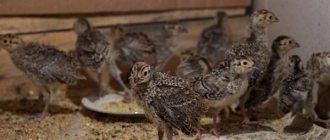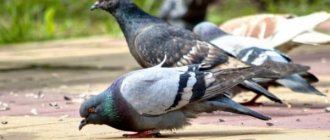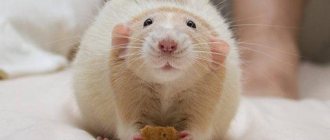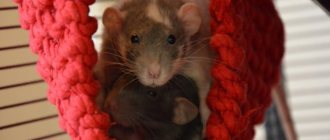The rat is an amazing pet that everyone in the household loves, so they try to prolong its life as much as possible. The basis for a pet’s good health is proper living conditions and a nutritious diet.
Not everyone thinks about what to feed a rat correctly. It is generally accepted that it is omnivorous and indestructible; it can easily eat even a piece of cardboard or sawdust. In most situations, rat owners go in two ways: either they feed the rat like a hamster, or they give away table scraps. Both of these approaches are wrong.
In fact, feeding a rat correctly is not difficult. You need to choose only healthy foods and give her the right amount of proteins, fats and carbohydrates.
Diet composition
The basis of a domestic rat's diet is a grain mixture. It is better to choose a ready-made mixture than to create a menu yourself, adding ingredients in the correct percentage. Food can be given without restrictions; a rare rat will eat more than 30 g.
In addition to the grain mixture, it is necessary to add succulent feed to the diet. These are vegetables, herbs, fruits, salads. Protein should also be present in the diet. This is especially true during active growth, pregnancy or breastfeeding.
In addition, you can give your pet treats. These can be seeds, nuts, dried fruits. There should be a limited amount of treats in the diet; it is best to use them as rewards.
The diet looks something like this: grains (60%), vegetables and herbs (20%), meat and eggs (10%). The rest of the diet consists of fermented milk products and treats.
Nutrition of newborn rats
Naturally, immediately after birth, little rat pups feed exclusively on mother's milk. Therefore, it is necessary, first of all, to take care of the mother’s correct diet. After about a month, your pets can be gradually transferred to regular, proper, nutritious food.
There are still cases when, for some reason, a mother cannot feed her baby, so there is no way to do without human help.
You can replace mother's milk with dog or goat milk. If this is not possible, then purchase ready-made mixtures at a pet store and feed the babies according to the scheme given in the instructions.
For the first half month of life, pups need to be fed every 2 hours throughout the day. After this period, the number of feedings should be reduced and done every 4 hours.
During the month, the baby can be gradually switched to adult food. First, introduce your pet to fruits and vegetables. Then add grains to your diet. Don't forget about fermented milk products, which will help normalize intestinal function.
Choosing food
The basis of a rat's diet is a grain mixture. You need to choose a trusted manufacturer who maintains balance when formulating feed. If you can’t find good ready-made food, it’s better to cook it yourself than to buy low-quality food, which consists of almost 80% oats. A complete diet should include oats, wheat, barley and rye.
It is better not to take food in a cardboard box, as it is stored in unsealed packaging, and if it was near chemicals, the rat can easily get poisoned. You only need to buy formulations in airtight packaging, and it is better to do this not in a regular supermarket, but in a specialized veterinary store.
You can buy not only grain mixture, but also granulated food. This food is similar in composition to regular grain food; it is purchased when the rat eats selectively, eating the most delicious food and leaving the grain untouched.
Care and maintenance
An albino does not require special care. It is enough to feed them on time, make sure that they always have access to fresh water and keep the cage clean.
Many albino owners prefer corn litter, as it is not an allergen and easily absorbs odors. It is enough to change it every 3-4 days. Complete cell processing is carried out every two weeks. It is washed with soap and soda solution, doused with boiling water and dried.
For health, animals need to be given physical exercise, which they cannot get by constantly sitting in a cage. To do this, they are allowed to run around the apartment under strict supervision. If there are two white rats in the house, it is better to let them out one by one. It will be difficult to keep track of the nimble albinos at once. Walking outside is only allowed on the owner's arms or shoulder when using a special harness. Otherwise, the animal may run away when frightened.
Vegetables and fruits for rats
Every day the rat needs to receive juicy foods. It is better to give preference to lettuce and vegetables, they are low in calories, but fruits and berries are high in sugar; it is better not to abuse them and use them more as a treat.
Succulent feeding should be given in limited quantities. If the norm is exceeded, the feces may become green, smelly and too soft, sometimes leading to diarrhea.
When feeding succulent food, preference is given to local and seasonal fruits; the peel must be removed; an adult rat should be given about 30 g per day. New types of foods are introduced gradually, it is important to monitor the animal’s reaction and well-being.
From vegetables you can give carrots, cucumber, zucchini, pumpkin, from greens parsley, dill and basil are suitable, lettuce leaves can be added to the diet: spinach, corn, arugula, chard.
Fruits you can use are apple, peach, banana, apricot. You can occasionally pamper your rat with berries. These can be wild strawberries, strawberries, currants, raspberries, cherries and blueberries.
What to feed rodents during pregnancy
If you are ready to reproduce these beautiful animals, then their body should be properly prepared in advance, and first of all, their nutrition should be adjusted. If your pet has gained excess weight, then get rid of barley, corn, and other foods that contain a lot of calories. Also, do not indulge in foods containing fiber, fats and carbohydrates.
During pregnancy, make sure that your decorative rat receives all the necessary vitamins and beneficial microelements. It is best to include fish and poultry in your diet. To provide the body with minerals, give slaked lime, shell rock and chalk.
Avoid foods such as grapes, cucumbers, liver, onions, lettuce, and eggs during this period.
Protein in a rat's diet
A rat is not a rabbit or a guinea pig, it cannot thrive on a vegetarian diet, it is important for it to get protein. Adults are given protein food twice a week, and young animals twice as often. But moderation is important in this matter - an adult animal needs only 20 g at one time.
The rat can be given lean boiled meat, boiled eggs, fish, shrimp or squid. If you have several rats living at home, then you need to give them protein supplements individually, since they really love such food and can fight for it. As a result, someone will be oversaturated, and someone will not receive their norm.
If you give a rat an egg, boil it soft-boiled so that the rat does not choke on the boiled yolk. A quail egg can be given with the shell, the rat will peel it itself or eat it straight away.
The animal loves fish or seafood, but after eating it, its urine acquires an unpleasant odor.
Description of white decorative rats
White rats are rodents from the mouse family, with a body length of 10 to 35 centimeters. The length of the tail can be equal to or even exceed the length of the animal's body. Weight is up to 600 grams. The average adult raised at home weighs from 300 to 500 grams. The male always exceeds the female in size.
Domestic rats have retained all the strengths of their wild ancestors - ingenuity, adaptability to environmental conditions, the ability to distinguish “friend” from “enemy”. At the same time, domestic rodents did not inherit the negative qualities of their relatives - savagery and bloodthirstiness. Decorative rats do not emit a strong unpleasant odor, so they require less care and attention.
The fur color of rodents is usually pure white or white with small spots of gray, black or red. Scientists and breeders also managed to breed a pure white rat with red eyes.
In a group of rats living together, a hierarchy is built. Adult males occupy a dominant position. At the same time, they demonstrate tolerance towards subordinate individuals and the younger generation, without showing aggression. Such a healthy climate is created with high-quality care for rodents and long-term maintenance without frequent changes of animals. When replacing rats or introducing new ones, clashes between females are possible.
White rats live for about two and a half years, in rare cases it is possible to extend their life to three years. Average life expectancy is largely determined by the quality of life and care of the pet. Rodents that are kept in poor conditions and eat low-quality food live much shorter - up to one year.
Unlike many of their relatives, they prefer to be active during the daytime and rarely sleep. Young individuals are active and love to play, while adults prefer calm, silence and affection.
Rats are quite smart animals. They quickly get used to the established daily routine, are trainable and can remember some simple commands, for example, respond by name.
With systematic training, rodents are able to do many tricks: stand on their hind legs, spin a wheel on command, hide on demand and overcome obstacles.
Rat and milk
Many rats love sour milk. It is an excellent source of protein and calcium at the same time. But not all animals digest lactose due to a lack of lactase. In this case, the animal may have a stomach ache and stool upset.
Whole milk is contraindicated for rats, as are fatty dairy products. If tolerated well, you can give your rat cottage cheese, yogurt, fermented baked milk and other foods. It is important that their fat content is below 5% and that they do not contain sugar or other additives harmful to the animal. It is necessary to introduce such food into the diet gradually in small portions and carefully monitor the animal’s health. Fermented milk products are not given on days when other protein foods are given.
Basic principles of feeding
As for food portions, there should be moderation in everything. You should not overfeed a decorative rat, as this can lead to unnecessary excess weight. If your pet leaves a lot of food in the cage, you need to reduce the amount.
Try not to give your rat everything you eat yourself. There are specialized feeds that contain all the necessary components of plant and animal origin.
Considering that these animals are predominantly nocturnal inhabitants, they need the main portion of food in the evening. In general, they are provided with 2 meals a day - morning and evening.
Don't forget to include something hard in your diet so that your rats have the opportunity to wear down their growing teeth.
Treats for rats
The rat is trainable; it can be taught to carry out several simple commands. But during training, you need to encourage the animal without harming it. And even without training, sometimes you want to pamper your pet with a tasty treat.
The main thing to remember is that the treat should not be sweet. Use nuts or seeds, give 1 piece to the paws a couple of times a week. This is a fatty and high-calorie product that can cause damage in large quantities. Nuts or seeds should not be fried or salted. You can give watermelon, pumpkin, sunflower, and sesame seeds.
Other incentive products may include:
- unsweetened wheat or corn flakes;
- biscuits;
- puffed rice or popcorn without additives;
- pasta;
- porridge.
You can take a stick and dip it in yogurt; the rat loves to lick it.
Authorized Products
The owner needs to know what to feed a decorative rat at home. The main product of a balanced diet is grain. You can buy grain food at a pet store or assemble it yourself. It is not recommended to purchase special food for animals in unverified stores, because... they may be treated with chemicals. Mixtures for rodents are divided into three categories, their difference lies in price and quality:
- Economy class food. The mixture consists of grain and grass granules. The granules have no nutritional value for rodents. For domestic rats, add sunflower seeds or nuts to the food. Protein foods should be given as a supplement to the mixture.
- Premium food. The mixture contains rye and oats instead of expensive wheat. Due to the increased fat content, it is necessary to dilute the feed with additional purchased grain. To ensure that your pet receives microelements, proteins are included in the menu.
- Super premium food. All ingredients are balanced and contain animal protein. The fat content of the mixture is no more than 10%.
List of foods allowed for consumption by pet rats:
- Green food: lettuce, parsley, plantain, dill. Excess of succulent food leads to disruption of the gastrointestinal tract.
- A complex of vitamins consisting of specialized nutritional supplements and fish oil.
- The rat eats corn, wheat, and oatmeal. They are a source of vitamin E. In winter, millet, barley and sunflower seeds should be given.
- Specialized chalk and stones as mineral supplements.
- Dairy products with a low fat content are suitable for feeding baby rats. Fermented milk products have a positive effect on digestion. For example, kefir, cottage cheese and yogurt without adding dyes. Do not give milk and lactic acid products that have expired. They can cause serious poisoning. To avoid stomach problems, you should introduce dairy products gradually.
- Potatoes, cabbage and turnips should be given cooked to avoid gas formation in the animals.
- It is allowed to feed your pet rat boiled beef, chicken and pork. You can add meat food for cats or bones, crushed into powder, to the diet. It is recommended to feed a lactating rat with meat. Meat products should not be given raw.
- Fish should not be fatty. When cooking, do not use salt or spices.
- You can give any type of nuts except almonds. Eating it in large quantities will lead to obesity.
- Raw pasta as dry food. It is recommended to add legumes, soy or lentils to them.
- You can include raspberries, blueberries, currants and strawberries in your pet's menu as treats.
- Hard-boiled quail eggs. Should be given once a week.
- Rodents can eat fruit. Before use, you should remove the seeds from them. They are a source of hydrocyanic acid, which is dangerous for rats. You can add dried fruits to your diet, such as raisins, dried apricots and prunes.
Diseases
Common ailments in pets:
- Problems with teeth, their excessive growth. Sometimes, due to overgrown teeth, the animal cannot eat or even close its jaws.
- Mycoplasma infection.
- Allergies.
- Suppuration and skin problems.
- Infection with parasites (infection with ticks is especially common).
Only a veterinarian or a rodent specialist - a ratologist - should treat animals, because these pets react very sensitively to any medications, and errors in dosage can be fatal. In addition, due to the rapid metabolism, the disease can overcome an animal faster than a larger pet. Decorative rats and mice are easy to care for and maintain; they easily and happily interact with people, so it is not surprising that these rodents are gaining more and more popularity as pets.
How did domestic rats appear?
White rats first appeared in Eastern countries; in the 19th century, animals appeared in England and were used for public entertainment. Many rich people kept white rats, which were a curiosity.
Subsequently, white pets began to be used in various laboratory tests. It was at this time that special pets began to be bred, which have a large number of distinctive qualities in comparison with their gray relatives.
Why should you have a rat as a pet?
- White domestic rats are clean animals, so there is practically no dirt from the pet.
- The rodent can perform tricks while playing, so it is ideal for children.
- The animal spends most of its time in a cage, where she also sets up places for going to the toilet and a corner for eating.
- The rodent is active and, with proper training, can improve the mood of any family member; it loves to go for walks with its owners.
- If you properly care for your white pet, no difficulties will arise; the animal does not require frequent feedings or other types of additional care.
Taming and training your pet
The first thing you need when training is a treat. As a treat, you can use a sunflower seed or a small piece of meat (eggs); you cannot use sweets. The first step is to gain the animal's trust in you. There are very sociable individuals who are happy to communicate with the owner, however, there are those who have difficulty making contact.
A rat can be trained to:
- Accustom to a nickname;
- Train to come running when you call;
- Train yourself to stand on your hind legs;
- Teach him to return to the cage at a certain time or at your request;
- Build her a mini-town and teach her to run up the stairs;
- Any simple tricks you can think of.
When giving a treat, say your pet's name. The nickname should be simple and sonorous, so it is better perceived by the animal; after all, these are not people and memorizing long phrases is not typical for them. After a while, at the sound of your voice, the pet will begin to wake up and run towards you. If you are completely confident in your animal, you can let it walk around the apartment. From time to time you need to call him and treat him with a treat, otherwise one day you will have to catch him throughout the apartment, and this is very difficult, due to the fact that rats are very nimble. Train your rat to return to the cage. To do this, pour out the food, call your pet, and tap the bowl at the same time.
When training a rat, you must remember its safety; it is advisable not to leave it alone in the free range, it can run wild, chew wires or fall somewhere. A rat is not a dog, it will take a lot of time and effort to teach it something, if you do not have a reserve of patience, then it is better not to start.











